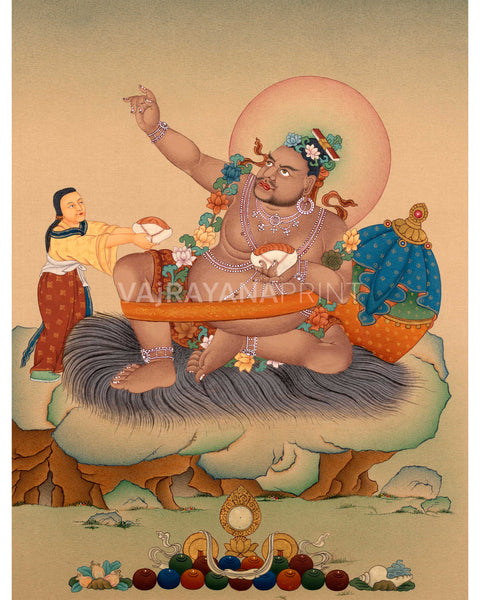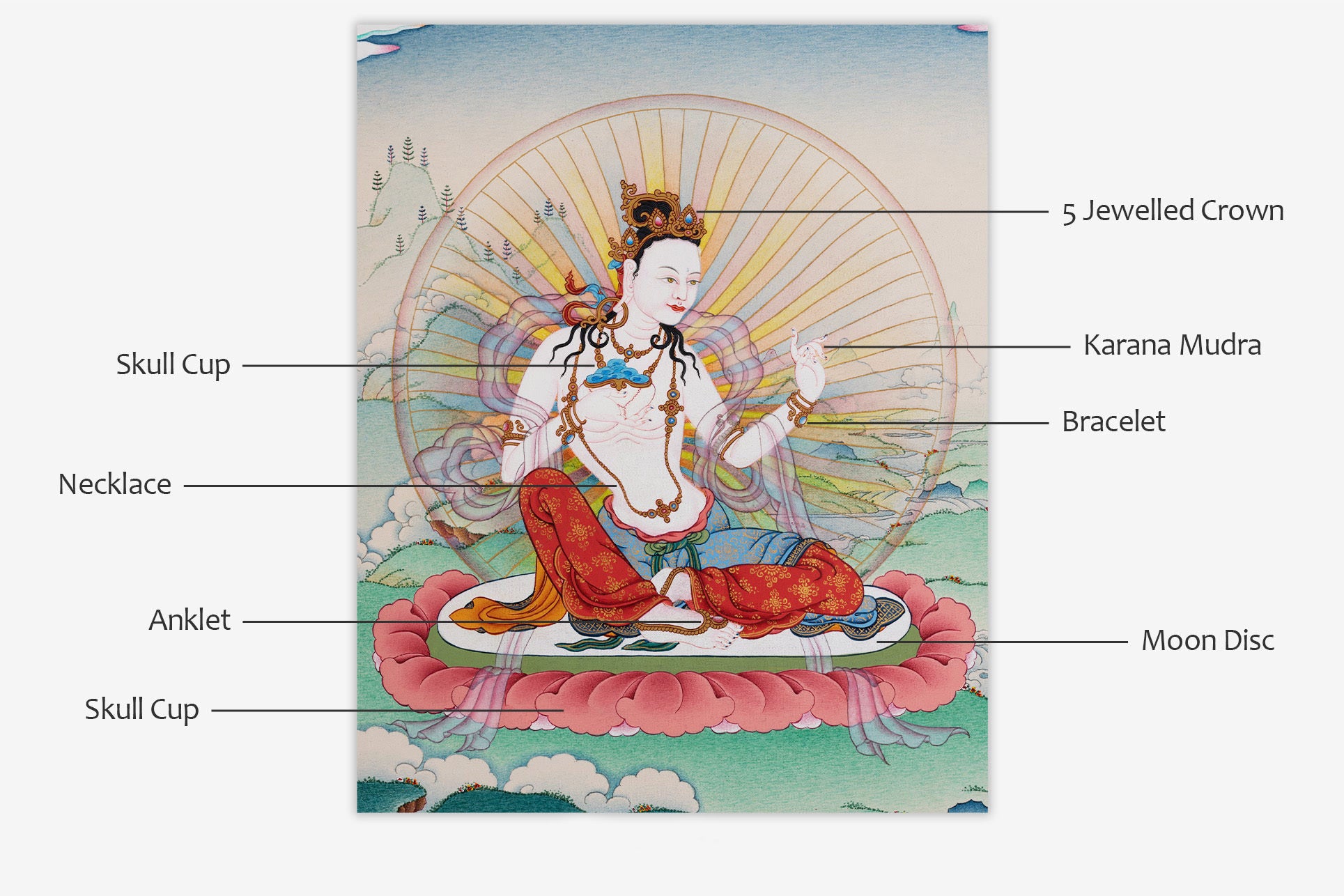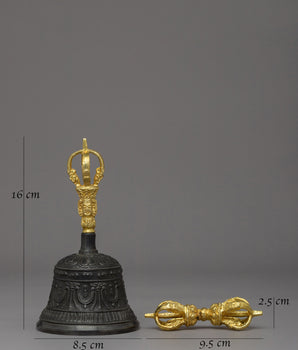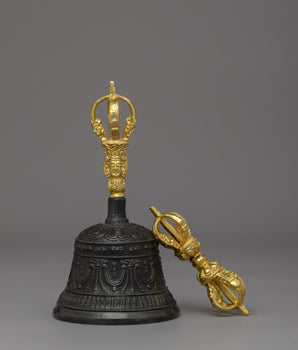Sukhasiddhi Magic: Illuminate Your Path to Well-Being and Fulfillment
Sukhasiddhi Dakini, a prominent figure in Tibetan Buddhism, specifically within the Kagyu lineage, is a model of spiritual transformation and feminine wisdom. Her evolution from an ordinary existence to a revered yogini illustrates the possibility of spiritual awakening in any life situation.
Sukhasiddhi, the Tibetan yogini and spiritual guru whose name translates to "Attainment of Bliss," captivates with her intriguing story. Recognized as one of the eighty-four mahasiddhas—exceptionally skilled practitioners of tantric Buddhism—she was born in the 11th century. Sukhasiddhi's life is characterized by profound devotion, unwavering commitment, and extraordinary events that propelled her to the pinnacle of spiritual realization.
Key Takeaways:
- Sukhasiddhi is a crucial figure in Tibetan Buddhism, particularly in the Kagyu lineage.
- Her life exemplifies profound spiritual transformation.
- Sukhasiddhi's teachings contribute significantly to Tibetan Buddhist practices.
- Her story is a source of inspiration for spiritual aspirants, especially women.
Early Life and Transformation
The Ordinary Beginnings
Sukhasiddhi commenced her life in humble circumstances. Born into a modest family in Kashmir, she faced the common challenges of everyday life. However, her narrative underwent a remarkable shift, underscoring the potential for profound spiritual awakening in individuals from diverse backgrounds.
Originally named Kunga Nyingpo, Sukhasiddhi displayed remarkable intelligence and compassion from her early years. Raised in a nurturing environment, her education seamlessly blended ancient wisdom with traditional Tibetan teachings passed down through generations.
Turning Point
The pivotal moment in Sukhasiddhi's journey she occurred when she faced estrangement from her family. In her quest for solace and purpose, she crossed paths with a Buddhist teacher who discerned her spiritual potential and introduced her to transformative tantric practices. This turning point set the stage for Sukhasiddhi's transformative spiritual journey.
Shortage of Food
In a pivotal episode of Sukhasiddhi's life, steeped in legend, she was in a challenging circumstance. Married and the mother of three sons and three daughters, her family faced adversity, leaving with only a single container of rice.
In a desperate search for sustenance, her son and husband roamed, seeking food through begging. Returning home without success, they prepared to consume the last rice container, believing it their sole sustenance.
However, Sukhasiddhi, embodying a spirit of generosity, encountered a man even more desperate for food. Unwavering in her compassion, she shared the last of her family's provisions with him, assuming her husband and children would return with more.
Outcast From Family
Upon their return, hungry and expecting to consume the remaining rice, Sukhasiddhi's family expressed anger and sadness. They accused her of giving away their last food amidst their misery, leading to her expulsion from the household due to their fury and frustration.
This poignant incident became a turning point in Sukhasiddhi's journey, setting the stage for her profound spiritual transformation. Following her expulsion from the family, Sukhasiddhi embarked on a westward journey to Oddiyana (Swat Valley in modern Pakistan).
There, she managed to obtain a measure of grain, skillfully crafting it into beer to establish herself as a merchant. A yogini frequented Sukhasiddhi each day to purchase her renowned beverage, considering it the best available. Intrigued, Sukhasiddhi inquired about the intended recipient of the drink, and the yogini revealed it was for the Great Yogi Virupa residing in the jungle.
| Event | Description |
| Birth | Born in a modest family in Kashmir |
| Family Life | Lived an ordinary life with typical struggles |
| Transformation | Cast out by family, leading to spiritual seeking |
Meeting With Mahasiddha Viruapa
Upon learning of Virupa, Sukhasiddhi generously provided her best beer without accepting payment. Later, Virupa, curious about the source of the free drinks, questioned his consort.
Click here to view our Mahasiddha Virupa Thangka Print
She explained that a woman with unwavering faith, Sukhasiddhi, had gifted her best beer to the forest-dwelling Yogi. Recognizing Sukhasiddhi's mighty faith, Virupa sought to liberate her from the cycles of samsara. He instructed his consort to summon the older woman, who arrived with hog meat and a jug of beer.
Virupa, acknowledging her devoted faith, bestowed upon Sukhasiddhi all four complete empowerments for yogic practices. The older woman transformed into a Wisdom Dakini, taking on the name Sukhasiddhi. This meeting marked a profound chapter in Sukhasiddhi's spiritual journey.
Enlightenment Of Sukhasiddhi
In the face of obstacles on the path to enlightenment, Sukhasiddhi demonstrated a triumphant spirit. Her spiritual journey encountered various challenges, including internal self-doubt and external skepticism.
However, Sukhasiddhi's unwavering faith, resilience, and steadfast commitment enabled her to surmount these hurdles. After years of dedicated practice and unwavering commitment, Sukhasiddhi achieved profound spiritual enlightenment.
Liberated from the bonds of pain and illusion, she gained a deep understanding of the underlying unity of existence and the interconnectedness of all things.
Teachings and Philosophical Contributions
- Core Teachings
Sukhasiddhi's teachings center on attaining awareness of innate Buddha nature and the journey to enlightenment. Renowned for their clarity and accessibility, her instructions demystify profound Buddhist concepts, rendering them understandable to a broad audience.
Rather than marking the end of her spiritual journey, enlightenment signaled the beginning of Sukhasiddhi's role as a spiritual teacher. Sharing her knowledge and wisdom, her teachings resonated with honesty, compassion, and a profound understanding of humanity's condition.
Through the power of her realizations, Sukhasiddhi demonstrated the ability to purify and transform her body into a rainbow body, showcasing the transformative potential of spiritual practice.
- Impact on Vajrayana Buddhism
Her teachings significantly influenced Vajrayana Buddhism, highlighting the significance of direct experience and the alchemy of transforming everyday encounters into pathways leading to enlightenment. Sukhasiddhi's insights continue to shape the essence of Vajrayana practices.
| Teaching | Description |
| Buddha-Nature | Emphasizing the innate potential for enlightenment in all beings |
| Path to Enlightenment | Practical instructions for spiritual awakening |
Sukhasiddhi's Iconography in the Arts
Click here to view our Dakini thangka collection
In artistic representations, Sukhasiddhi is depicted as serene and contemplative, symbolizing her inner tranquility and connection to spiritual realms. Often, her hands form mudras, commonly the teaching gesture, underscoring her role as a spiritual guide.
Adorned in traditional Tibetan attire, Sukhasiddhi's clothing embodies tradition and its teachings. Elaborate robes and exquisite jewelry further emphasize her elevated spiritual position. Her peaceful expression and gentle gaze reflect the depth of her understanding and compassion.
The visual portrayal of Sukhasiddhi, found in thangka paintings and statues, serves as a form of visual teaching, communicating her spiritual path, knowledge, and enlightenment. Her representation's meticulous attention to detail encourages students to contemplate her teachings and aspire to their spiritual growth.
Sukhasiddhi's life is a unique example of individual potential and the transformative power of spiritual development. Her journey from an ordinary person to an enlightened master is a beacon of hope and inspiration for those seeking a profound connection with the universe and themselves.
Sukhasiddhi in Kagyu Lineage
-
Integration into Kagyu Teachings
Sukhasiddhi's teachings found integration into the Kagyu lineage, a critical school within Tibetan Buddhism. Her profound insights and methods evolved into a foundational element of their spiritual practices. -
Tibetan Buddhism Legacy
In Tibetan Buddhism, Sukhasiddhi's legacy endures through the sustained significance of her teachings within the Kagyu lineage, impacting numerous practitioners and spiritual leaders. Her contributions remain integral to the spiritual fabric of Tibetan Buddhism.
Influence on Tibetan Buddhist Practices
- Meditation Techniques
Sukhasiddhi's meditation techniques, especially those centered on cultivating compassion and wisdom, have gained extensive acceptance in Tibetan Buddhism.
Meditation played a pivotal role in Sukhasiddhi's path to enlightenment. She cultivated inner calm and mindfulness by embracing meditation, unlocking profound truths about life.
Compassion is at the core of her teachings—an unwavering affection for all sentient beings. Sukhasiddhi emphasized that compassion is the key to unlocking the doors to spiritual enlightenment.
- Empowering Women in Buddhism
Her narrative holds special empowerment for women in Buddhism, illustrating the capacity for spiritual realization irrespective of gender. Sukhasiddhi's story is a testament to the inclusive nature of spiritual attainment within the Buddhist tradition.
Sukhasiddhi's journey from an ordinary life to a revered yogini is a powerful reminder of the potential for spiritual awakening in all of us. Her teachings and legacy inspire and guide practitioners on the path to enlightenment.
Sukhasiddhi Mantra
"Om Sukhasiddhi Hum"
Om: Symbolizing universal awareness and the essence of all creation, this primordial sound represents the unity of existence and the interdependence of all entities.
Sukhasiddhi: The central focus of the mantra, Sukhasiddhi, translates to "Attainment of Bliss." Her name encapsulates the ultimate goal of spiritual practice – transcending temporary pain to enter a state of profound and lasting happiness.
Hum: This syllable signifies the undivided and unbreakable quality of enlightenment, serving as a potent seed syllable evoking the wisdom of the wise and the enlightened mind.
Reciting Sukhasiddhi's mantra with devotion and purpose can bring forth a wealth of spiritual and psychological advantages, including:
- Inner Peace and Calmness: Regular chanting of the mantra calms the mind, reducing agitated feelings and thoughts and facilitating inner peace.
- Spiritual Connection: The mantra establishes a direct link with the enlightened energy of Sukhasiddhi, creating a powerful connection with her spiritual understanding and guidance.
- Transformation and Healing: The vibrational energy of the mantra aids in dissolving unfavorable patterns and obstructions, fostering inner healing and facilitating individual change.
- Improved Meditation: Including the mantra in your meditation routine enhances focus, leading to higher awareness and deeper insight.
- Bliss Cultivation: Sukhasiddhi's mantra, embodying bliss, assists practitioners in finding greater happiness, satisfaction, and a sense of spiritual fulfillment.
Sukhasiddhi stands as a beacon of hope and inspiration within the Buddhist tradition. Emphasizing the potential for enlightenment in every individual, her teachings resonate with modern practitioners. Her story is a compelling illustration of the transformative influence of spiritual practice, offering guidance to those traversing the path to spiritual awakening.










